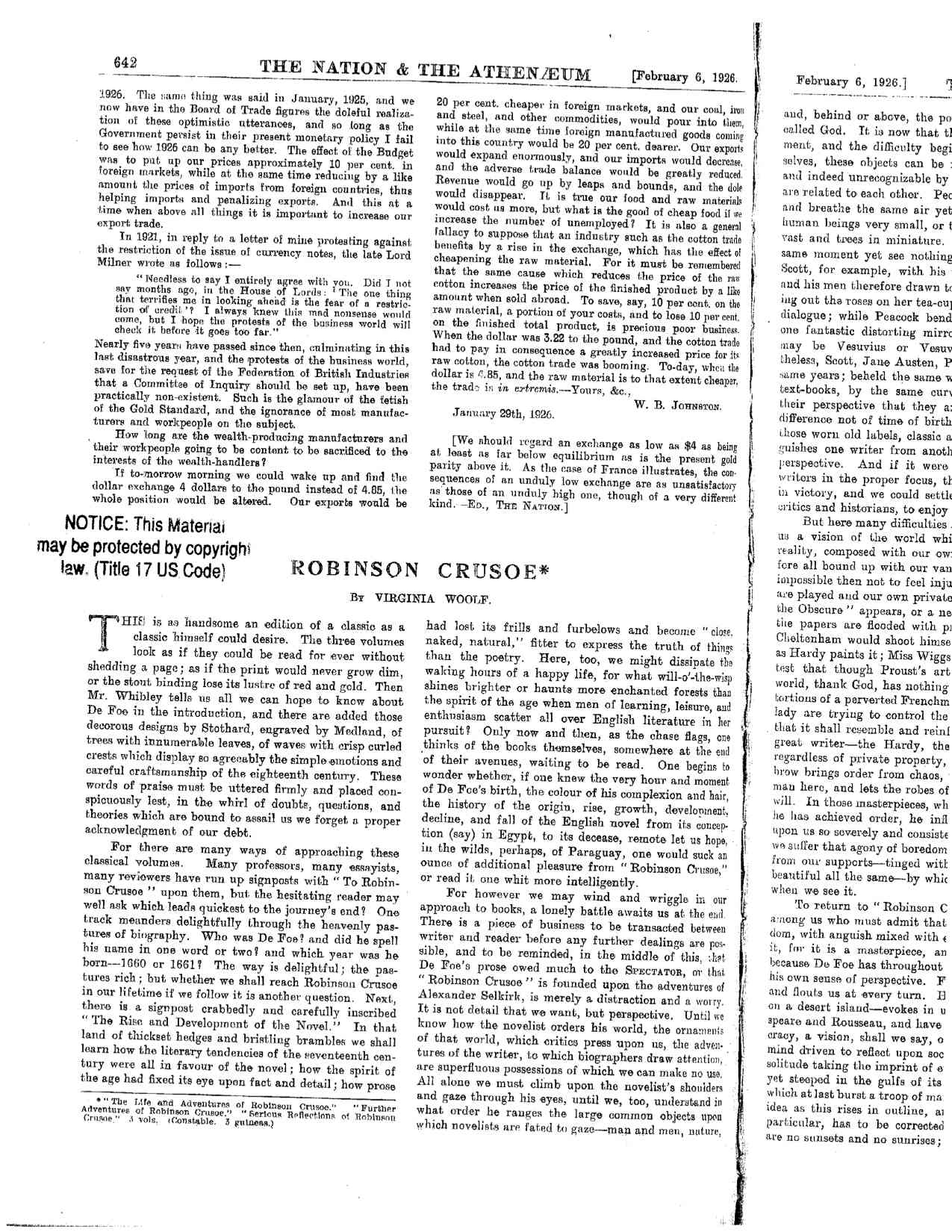
ROBINSON CRUSOE*
By VIRGINIA WOOLF.
THIS is as handsome an edition of a classic as a
classic himself could desire. The three volumes
look as if they could be read for ever without
shedding a page; as if the print would never grow dim,
or the stout binding lose its lustre of red and gold. Then
Mr. Whibley tells us all we can hope to know about
De Foe in the introduction, and there are added those
decorous designs by Stothard, engraved by Medland, of
trees with innumerable leaves, of waves with crisp curled
crests which display so agreeably the simple emotions and
careful craftsmanship of the eighteenth century. These
words of praise must be uttered firmly and placed con-
spicuously lest, in the whirl of doubts, questions, and
theories which are bound to assail us we forget a proper
acknowledgment of our debt.
For there are many ways of approaching these
classical volumes. Many professors, many essayists,
many reviewers have run up signposts with “To Robin-
son Crusoe” upon them, but the hesitating reader may
well ask which leads quickest to the journey’s end? One
track meanders delightfully through the heavenly pas-
tures of biography. Who was De Foe? and did he spell
his name in one word or two? and which year was he
born—1660 or 1661? The way is delightful; the pas-
tures rich; but whether we shall reach Robinson Crusoe
in our lifetime if we follow it is another question. Next,
there is a signpost crabbedly and carefully inscribed
“The Rise and Development of the Novel.” In that
land of thickset hedges and bristling brambles we shall
learn how the literary tendencies of the seventeenth cen-
tury were all in favour of the novel; how the spirit of
the age had fixed its eye upon fact and detail; how prose
_____________________________________________
* “The Life and Adventures of Robinson Crusoe.” “Further
Adventures of Robinson Crusoe.” “Serious Reflections of Robinson
Crusoe.” 3 vols. (Constable. 3 guineas.)
[new column]
had lost its frills and furbelows and become “close,
naked, natural,” fitter to express the truth of things
than the poetry. Here, too, we might dissipate the
waking hours of a happy life, for what will-o’-the-wisp
shines brighter or haunts more enchanted forests than
the spirit of the age when men of learning, leisure, and
enthusiasm scatter all over English literature in her
pursuit? Only now and then, as the chase flags, one
thinks of the books themselves, somewhere at the end
of their avenues, waiting to be read. One begins to
wonder whether, if one knew the very hour and moment
of De Foe’s birth, the colour of his complexion and hair,
the history of the origin, rise, growth, development,
decline, and fall of the English novel from its concep-
tion (say) in Egypt, to its decease, remote let us hope,
in the wilds, perhaps, of Paraguay, one would suck an
ounce of additional pleasure from “Robinson Crusoe,”
or read it one whit more intelligently.
For however we may wind and wriggle in our
approach to books, a lonely battle awaits us at the end.
There is a piece of business to be transacted between
writer and reader before any further dealings are pos-
sible, and to be reminded, in the middle of this, that
De Foe’s prose owed much to the SPECTATOR, or that
“Robinson Crusoe” is founded upon the adventures of
Alexander Selkirk, is merely a distraction and a worry.
It is not detail that we want, but perspective. Until we
know how the novelist orders his world, the ornaments
of that world, which critics press upon us, the adven-
tures of the writer, to which biographers draw attention,
are superfluous possessions of which we can make no use.
All alone we must climb upon the novelist’s shoulders
and gaze through his eyes, until we, too, understand in
what order he ranges the large common objects upon
which novelists are fated to gaze—man and men, nature,






